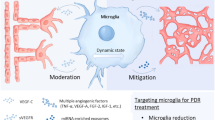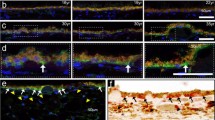Abstract
Aims
Ischemia-induced neovascularization is the key feature of proliferative diabetic retinopathy. Macrophage migration inhibitory factor (MIF) is a pleiotropic proinflammatory and proangiogenic cytokine, and its levels are elevated in the vitreous of patients with proliferative diabetic retinopathy. In this study, we aimed at investigating the relative potential of MIF in the ischemia-induced retinal neovascularization.
Methods
Both WT and MIF-knockout mice were subjected to the retinopathy of prematurity (ROP) model. Intraretinal vessel regrowth was assessed by whole-mount immunofluorescence, and preretinal neovascularization was analyzed in retinal vertical sections after periodic acid-Schiff staining in the hypoxic stage of the ROP model. Gene expression of selected proangiogenic and proinflammatory factors at postnatal day 13 (p13) was measured by real-time PCR. Vascular endothelial growth factor (VEGF) expression, recruitment of endothelial progenitor cells (EPCs) and microglial activation were analyzed with immunofluorescence.
Results
MIF deficiency increased areas of vascular obliteration by 49%, reduced sprouting tips by 27% and inhibited preretinal angiogenesis by 35%. VEGF expression was reduced in Müller cells of MIF-knockout mice. MIF absence reduced gene expression of erythropoietin, tumor necrosis factor alpha and intercellular adhesion molecule-1 by 30, 70 and 50%, respectively, decreased the number of retinal EPCs by 37.5% and inhibited microglial activation in the hypoxic condition.
Conclusions
In conclusion, we found that MIF has proangiogenic and proinflammatory properties in retinal neovascularization. The proangiogenic role of MIF in ischemia-induced retinal neovascularization is associated with the expression of VEGF and erythropoietin, EPC recruitment and inflammation. Therefore, MIF has a potential role in the pathological angiogenesis of proliferative retinopathy.






Similar content being viewed by others
References
Watanabe D, Suzuma K, Matsui S et al (2005) Erythropoietin as a retinal angiogenic factor in proliferative diabetic retinopathy. N Engl J Med 353(8):782–792. doi:10.1056/NEJMoa041773
Praidou A, Androudi S, Brazitikos P, Karakiulakis G, Papakonstantinou E, Dimitrakos S (2010) Angiogenic growth factors and their inhibitors in diabetic retinopathy. Curr Diabetes Rev 6(5):304–312
Smith LE, Wesolowski E, McLellan A et al (1994) Oxygen-induced retinopathy in the mouse. Invest Ophthalmol Vis Sci 35(1):101–111
Hammes HP, Brownlee M, Jonczyk A, Sutter A, Preissner KT (1996) Subcutaneous injection of a cyclic peptide antagonist of vitronectin receptor-type integrins inhibits retinal neovascularization. Nat Med 2(5):529–533
Demircan N, Safran BG, Soylu M, Ozcan AA, Sizmaz S (2006) Determination of vitreous interleukin-1 (IL-1) and tumour necrosis factor (TNF) levels in proliferative diabetic retinopathy. Eye 20(12):1366–1369. doi:10.1038/sj.eye.6702138
Hernandez C, Burgos R, Canton A, Garcia-Arumi J, Segura RM, Simo R (2001) Vitreous levels of vascular cell adhesion molecule and vascular endothelial growth factor in patients with proliferative diabetic retinopathy: a case–control study. Diabetes Care 24(3):516–521
Gardiner TA, Gibson DS, de Gooyer TE, de la Cruz VF, McDonald DM, Stitt AW (2005) Inhibition of tumor necrosis factor-alpha improves physiological angiogenesis and reduces pathological neovascularization in ischemic retinopathy. Am J Pathol 166(2):637–644
Kociok N, Radetzky S, Krohne TU, Gavranic C, Joussen AM (2006) Pathological but not physiological retinal neovascularization is altered in TNF-Rp55-receptor–deficient mice. Invest Ophthalmol Vis Sci 47(11):5057–5065. doi:10.1167/iovs.06-0407
Fischer F, Martin G, Agostini HT (2011) Activation of retinal microglia rather than microglial cell density correlates with retinal neovascularization in the mouse model of oxygen-induced retinopathy. J Neuroinflammation 8:120. doi:10.1186/1742-2094-8-120
Zeng HY, Green WR, Tso MO (2008) Microglial activation in human diabetic retinopathy. Arch Ophthalmol 126(2):227–232. doi:10.1001/archophthalmol.2007.65
Mitamura Y, Takeuchi S, Matsuda A, Tagawa Y, Mizue Y, Nishihira J (2000) Macrophage migration inhibitory factor levels in the vitreous of patients with proliferative diabetic retinopathy. Br J Ophthalmol 84(6):636–639
Tashimo A, Mitamura Y, Nagai S et al (2004) Aqueous levels of macrophage migration inhibitory factor and monocyte chemotactic protein-1 in patients with diabetic retinopathy. Diabet Med 21(12):1292–1297. doi:10.1111/j.1464-5491.2004.01334.x
Asare Y, Schmitt M, Bernhagen J (2013) The vascular biology of macrophage migration inhibitory factor (MIF). Expression and effects in inflammation, atherogenesis and angiogenesis. Thromb Haemost 109(3):391–398. doi:10.1160/TH12-11-0831
Bacher M, Meinhardt A, Lan HY et al (1998) MIF expression in the rat brain: implications for neuronal function. Mol Med 4(4):217–230
Calandra T, Bernhagen J, Mitchell RA, Bucala R (1994) The macrophage is an important and previously unrecognized source of macrophage migration inhibitory factor. J Exp Med 179(6):1895–1902
Simons D, Grieb G, Hristov M et al (2011) Hypoxia-induced endothelial secretion of macrophage migration inhibitory factor and role in endothelial progenitor cell recruitment. J Cell Mol Med 15(3):668–678. doi:10.1111/j.1582-4934.2010.01041.x
Calandra T, Bernhagen J, Metz CN et al (1995) MIF as a glucocorticoid-induced modulator of cytokine production. Nature 377(6544):68–71. doi:10.1038/377068a0
Calandra T, Roger T (2003) Macrophage migration inhibitory factor: a regulator of innate immunity. Nat Rev Immunol 3(10):791–800. doi:10.1038/nri1200
Toh ML, Aeberli D, Lacey D et al (2006) Regulation of IL-1 and TNF receptor expression and function by endogenous macrophage migration inhibitory factor. J Immunol 177(7):4818–4825
Shyu LY, Yeh TM, Chang HH et al (2012) Macrophage migration inhibitory factor induces ICAM-1and thrombomobulin expression in vitro. Thromb Res 129(1):43–49. doi:10.1016/j.thromres.2011.08.011
Bernhagen J, Krohn R, Lue H et al (2007) MIF is a noncognate ligand of CXC chemokine receptors in inflammatory and atherogenic cell recruitment. Nat Med 13(5):587–596. doi:10.1038/nm1567
Amin MA, Volpert OV, Woods JM, Kumar P, Harlow LA, Koch AE (2003) Migration inhibitory factor mediates angiogenesis via mitogen-activated protein kinase and phosphatidylinositol kinase. Circ Res 93(4):321–329. doi:10.1161/01.RES.0000087641.56024.DA
Ke Q, Costa M (2006) Hypoxia-inducible factor-1 (HIF-1). Mol Pharmacol 70(5):1469–1480. doi:10.1124/mol.106.027029
Koong AC, Denko NC, Hudson KM et al (2000) Candidate genes for the hypoxic tumor phenotype. Cancer Res 60(4):883–887
Oda S, Oda T, Nishi K et al (2008) Macrophage migration inhibitory factor activates hypoxia-inducible factor in a p53-dependent manner. PLoS ONE 3(5):e2215. doi:10.1371/journal.pone.0002215
Chesney JA, Mitchell RA (2015) 25 Years on: a retrospective on migration inhibitory factor in tumor angiogenesis. Mol Med 21(Suppl 1):S19–S24. doi:10.2119/molmed.2015.00055
Chen J, Connor KM, Aderman CM, Willett KL, Aspegren OP, Smith LE (2009) Suppression of retinal neovascularization by erythropoietin siRNA in a mouse model of proliferative retinopathy. Invest Ophthalmol Vis Sci 50(3):1329–1335. doi:10.1167/iovs.08-2521
Bahlmann FH, De Groot K, Spandau JM et al (2004) Erythropoietin regulates endothelial progenitor cells. Blood 103(3):921–926. doi:10.1182/blood-2003-04-1284
Heeschen C, Aicher A, Lehmann R et al (2003) Erythropoietin is a potent physiologic stimulus for endothelial progenitor cell mobilization. Blood 102(4):1340–1346. doi:10.1182/blood-2003-01-0223
O’Leary O, Reid E, McVicar C et al (2013) A novel Erythropoietin-derived peptide regulates Endothelial Progenitor Cell (EPC) mediated retinal vasorepair. ARVO Annual Meeting (2013); Seattle, United States, p 4619
Asahara T, Murohara T, Sullivan A et al (1997) Isolation of putative progenitor endothelial cells for angiogenesis. Science 275(5302):964–967
Hristov M, Weber C (2008) Endothelial progenitor cells in vascular repair and remodeling. Pharmacol Res 58(2):148–151. doi:10.1016/j.phrs.2008.07.008
Jujo K, Ii M, Losordo DW (2008) Endothelial progenitor cells in neovascularization of infarcted myocardium. J Mol Cell Cardiol 45(4):530–544. doi:10.1016/j.yjmcc.2008.08.003
De Falco E, Porcelli D, Torella AR et al (2004) SDF-1 involvement in endothelial phenotype and ischemia-induced recruitment of bone marrow progenitor cells. Blood 104(12):3472–3482. doi:10.1182/blood-2003-12-4423
Kanzler I, Tuchscheerer N, Steffens G et al (2013) Differential roles of angiogenic chemokines in endothelial progenitor cell-induced angiogenesis. Basic Res Cardiol 108(1):310. doi:10.1007/s00395-012-0310-4
Grieb G, Piatkowski A, Simons D et al (2012) Macrophage migration inhibitory factor is a potential inducer of endothelial progenitor cell mobilization after flap operation. Surgery 151(2):268–277. doi:10.1016/j.surg.2010.10.008
Wang J, Lin J, Schlotterer A et al (2014) CD74 indicates microglial activation in experimental diabetic retinopathy and exogenous methylglyoxal mimics the response in normoglycemic retina. Acta Diabetol 51(5):813–821. doi:10.1007/s00592-014-0616-9
Acknowledgements
This study was supported by Grants from the DDG (Deutsche Diabetes Gesellschaft) and the EFSD (European Foundation for the Study of Diabetes). The authors thank P. Bugert and N. Dietrich for their excellent technical assistance.
Author information
Authors and Affiliations
Corresponding author
Ethics declarations
Conflict of interest
Jing Wang, Jihong Lin, Ulrike Kaiser and Hans-Peter Hammes have nothing to disclose. Paulaus Wohlfart is full research employee of Sanofi and involved in identification and validation of new therapeutic approaches in diabetes.
Ethical standard
All procedures performed in studies involving animals were in accordance with the ethical standards of the institution or practice at which the studies were conducted.
Human and animal rights
All applicable national and institutional guidelines for the care and use of animals were followed.
Informed consent
This article does not contain any studies with human participants performed by any of the authors.
Additional information
Managed by Massimo Porta.
Rights and permissions
About this article
Cite this article
Wang, J., Lin, J., Kaiser, U. et al. Absence of macrophage migration inhibitory factor reduces proliferative retinopathy in a mouse model. Acta Diabetol 54, 383–392 (2017). https://doi.org/10.1007/s00592-016-0956-8
Received:
Accepted:
Published:
Issue Date:
DOI: https://doi.org/10.1007/s00592-016-0956-8




